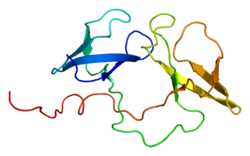In neuroscience, synaptic plasticity is the ability of synapses to strengthen or weaken over time, in response to increases or decreases in their activity...
30 KB (3,613 words) - 11:48, 17 April 2025
Chemical synapse (redirect from Synaptic cleft)
Forms of short-term plasticity include synaptic fatigue or depression and synaptic augmentation. Forms of long-term plasticity include long-term depression...
36 KB (4,277 words) - 19:24, 23 March 2025
Spike-timing-dependent plasticity (STDP) is a biological process that adjusts the strength of synaptic connections between neurons based on the relative...
61 KB (7,402 words) - 16:10, 14 May 2025
Neuroplasticity (redirect from Cortical plasticity)
Neuroplasticity, also known as neural plasticity or just plasticity, is the ability of neural networks in the brain to change through growth and reorganization...
120 KB (13,307 words) - 02:08, 26 April 2025
Heterosynaptic plasticity is a subtype of synaptic plasticity, referring to a chemical synapse's ability to undergo changes in strength, or efficacy of...
22 KB (2,676 words) - 04:33, 16 April 2025
adapt to changes in the connectivity and synaptic strength during development and learning. Homeostatic plasticity is also a negative feedback mechanism...
30 KB (3,446 words) - 15:35, 1 May 2025
Homosynaptic plasticity is one type of synaptic plasticity. Homosynaptic plasticity is input-specific, meaning changes in synapse strength occur only at...
17 KB (2,007 words) - 14:42, 21 April 2025
potentials. Nonsynaptic plasticity is a modification of the intrinsic excitability of the neuron. It interacts with synaptic plasticity, but it is considered...
47 KB (5,507 words) - 09:48, 16 January 2025
Metaplasticity (redirect from Synaptic homeostasis)
Abraham and M.F. Bear to refer to the plasticity of synaptic plasticity. Until that time synaptic plasticity had referred to the plastic nature of individual...
26 KB (3,823 words) - 11:52, 16 January 2024
Hebbian theory (redirect from Hebbian plasticity)
activity-dependent presynaptic facilitation are both necessary for synaptic plasticity and classical conditioning in Aplysia californica. While research...
32 KB (4,344 words) - 09:10, 18 May 2025
Short-term synaptic depression or synaptic fatigue, is an activity-dependent form of short term synaptic plasticity that results in the temporary inability...
17 KB (2,291 words) - 22:07, 22 March 2025
NMDA receptor (section Neural plasticity)
The NMDA receptor is thought to be very important for controlling synaptic plasticity and mediating learning and memory functions. The NMDA receptor is...
109 KB (12,198 words) - 04:47, 29 April 2025
development is the result of three predominant mechanisms: synaptic and homeostatic plasticity, and learning. When brain areas are impaired, remaining circuits...
43 KB (5,206 words) - 02:34, 29 April 2025
provide the basis for synaptic plasticity connected to learning and memory. Dendritic spines accomplish this by transforming synaptic input into neuronal...
34 KB (4,353 words) - 06:55, 24 November 2024
AMPA receptor (section Synaptic plasticity)
for the dendrite and axon development (synaptic plasticity). The first is direct phosphorylation of synaptic-associated protein 97(SAP97), a scaffolding...
75 KB (8,581 words) - 14:22, 3 May 2025
In neuroscience, synaptic scaling (or homeostatic scaling) is a form of homeostatic plasticity, in which the brain responds to chronically elevated activity...
16 KB (2,011 words) - 14:35, 3 December 2023
Bursting (section Synaptic plasticity)
combined with burst-dependent long-term plasticity, such multiplexing can allow neurons to coordinate synaptic plasticity across hierarchical networks. Burst...
24 KB (2,837 words) - 16:42, 10 May 2025
Cellular neuroscience (section Synaptic plasticity)
signal. Synaptic plasticity is the process whereby strengths of synaptic connections are altered. For example, long-term changes in synaptic connection...
12 KB (1,398 words) - 05:16, 30 July 2024
FMR1 (section Synaptic plasticity)
involvement of FMRP in synaptic plasticity. Synaptic plasticity requires the production of new proteins in response to activation of synaptic receptors. It is...
28 KB (3,412 words) - 06:11, 9 April 2025
Synapse (redirect from Synaptic inputs)
The formation of synaptic connections significantly depends on activity-dependent synaptic plasticity observed in various synaptic pathways. Indeed,...
42 KB (4,932 words) - 10:13, 13 May 2025
can penetrate in some cases the synaptic cleft to interfere with the synaptic transmission and thus control synaptic communication. Computational neuroscience...
41 KB (4,521 words) - 05:29, 2 November 2024
(Short-term Plasticity) and long term synaptic plasticity (Long-term Plasticity) in terms of storing information and changing in the efficiency of synaptic transmission...
17 KB (2,150 words) - 07:51, 8 May 2024
thus a form of short-term synaptic plasticity. The mechanisms underlying neural facilitation are exclusively pre-synaptic; broadly speaking, PPF arises...
15 KB (1,762 words) - 11:07, 25 October 2023
converge in the lateral amygdala. Long-term potentiation (LTP) and synaptic plasticity that enhances the response of lateral amygdala neurons to the conditioned...
24 KB (3,074 words) - 03:24, 10 March 2025
Dendrite (redirect from Dendritic plasticity)
2008). "The regulation of dendritic arbor development and plasticity by glutamatergic synaptic input: a review of the synaptotrophic hypothesis". The Journal...
33 KB (3,867 words) - 05:40, 21 April 2025
Postsynaptic density (redirect from Post-synaptic density)
state of the synapse. During synaptic plasticity, the total size of the PSD is increasing along with an increase in synaptic size and strength after inducing...
9 KB (969 words) - 20:12, 7 December 2024
roles in synaptic transmission and plasticity. 1. NMDA (N-methyl-D-aspartate) receptors: These receptors are involved in synaptic plasticity, learning...
64 KB (6,959 words) - 14:22, 3 May 2025
Long-term potentiation (section Synaptic tagging)
produces a long-lasting decrease in synaptic strength. It is one of several phenomena underlying synaptic plasticity, the ability of chemical synapses to...
64 KB (7,638 words) - 20:06, 10 May 2025
become more negative. SK channels are thought to be involved in synaptic plasticity and therefore play important roles in learning and memory. SK channels...
24 KB (2,730 words) - 07:06, 16 August 2022
the 2016 Gruber Prize in Neuroscience for his pioneering work on synaptic plasticity. At ION, Poo led a team of scientists that produced the world's first...
14 KB (1,268 words) - 18:46, 7 April 2025

















